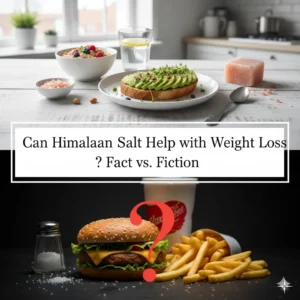Pink Himalayan salt is a naturally occurring mineral salt mined from ancient sea deposits in the Himalayan region, valued for its distinctive color and trace mineral content. For professionals in nutrition, food product development, or wellness branding, understanding its real versus perceived properties ensures truthful communication and responsible formulation. This article examines scientific insights into Himalayan salt’s role in weight management, explores how sodium influences hydration and metabolism, and offers evidence-based guidance for integrating it into balanced dietary practices.

Prerequisites: Tools and Materials
To critically evaluate claims about Himalayan salt and weight management, begin with credible information and a structured review process. The following essentials provide the clarity needed to distinguish verified nutrition science from popular misconceptions.
- Access to peer-reviewed research on salt intake, metabolism, and hydration.
- Knowledge of how dietary electrolytes influence water balance and overall health.
- A willingness to assess promotional claims objectively against available data.
- Optional: Himalayan salt products or blocks for practical culinary comparison.
Having these materials organized ensures a fact-driven perspective when analyzing Himalayan salt’s role in weight loss or wellness discussions.
Step-by-Step Guide to Evaluating Himalayan Salt for Weight Loss
Claims linking Himalayan salt to weight loss are common online, yet assessing them correctly requires a structured approach. By breaking the process into distinct steps—identifying common beliefs, comparing them with available research, and acknowledging actual benefits—you can gain an accurate, evidence-based perspective. This section explains how to interpret such claims using current nutrition science.
Step 1: Identify Common Weight Loss Claims
Begin by recognizing the main assertions surrounding pink Himalayan salt and weight management. Many sources suggest it boosts metabolism, flushes toxins, or accelerates fat burning, while others advertise “pink salt tricks” or saltwater cleanses as shortcuts to results. Most of these statements originate from anecdotes or marketing efforts rather than clinical evidence.
- Identify claims about improved metabolism, detoxification, or fat burning.
- Note social media trends pairing pink salt with lemon water or fasting routines.
- Keep in mind that few of these claims are supported by controlled research or expert review.
Step 2: Review Scientific Evidence
Next, evaluate those claims against credible research. Clinical studies show no measurable effect of Himalayan salt on fat metabolism or body composition. While sodium influences hydration levels, its impact is limited to water balance, not actual fat loss. Understanding the difference between temporary water retention and true changes in body mass helps avoid false conclusions from short-term fluctuations.
- Consult peer-reviewed studies examining pink salt’s influence on body composition.
- Seek guidance from registered dietitians or reliable nutrition organizations.
- Recognize that substituting high-calorie beverages with water—not salt—is what truly aids calorie control.
Step 3: Recognize the Genuine Benefits of Himalayan Salt
Finally, focus on the authentic advantages Himalayan salt offers. It contains trace minerals such as magnesium and potassium and is less refined than regular table salt. Cooking on a salt block can enhance flavor and make meal preparation more engaging, encouraging home cooking with whole ingredients. Its benefits lie in its culinary qualities, not in claims of detoxification or weight reduction.
- Value its trace minerals and natural texture as sensory and visual enhancements.
- Use it to prepare balanced, flavorful meals that promote consistent healthy eating habits.
- Treat it as a quality ingredient that complements evidence-based nutrition practices rather than replaces them.
Premium Pink Himalayan Salt Blocks for B2B
Partner with Jilin Ever Creation to source natural, FDA-approved Himalayan salt blocks crafted to elevate professional and culinary applications. Available with custom sizing, private labeling, and global distribution, these salt blocks deliver authentic flavor and refined presentation to your business.
While Himalayan salt itself doesn’t promote weight loss or detoxification, using it as a natural cooking surface can support healthier food preparation by reducing reliance on processed ingredients and adding a delicate mineral finish. High-quality salt products enhance both wellness-oriented dining and professional culinary standards.

How Hydration and Electrolytes Influence Weight Management
Water and electrolytes—primarily sodium, potassium, and magnesium—are essential for maintaining fluid balance and supporting proper muscle and nerve function. Sodium plays a central role by regulating fluid levels inside and outside cells, ensuring the body performs efficiently during everyday activities and physical effort.

When sodium intake increases, the body retains additional water to maintain equilibrium. This can lead to short-term weight fluctuations that represent water retention, not fat loss. Reducing sodium intake usually minimizes this temporary gain by allowing excess fluid to leave the body.
Replacing high-calorie drinks with water or lightly salted beverages helps cut unnecessary calories and promotes optimal hydration. This change supports better weight control, but the effect comes from lower sugar consumption and improved fluid balance—not from the salt itself.
Culinary Benefits of Himalayan Salt Blocks for Healthy Cooking
Cooking with Himalayan salt blocks imparts a gentle mineral note that enhances the natural flavor of fresh vegetables, meats, and seafood. This method encourages meals centered on whole ingredients instead of processed options, supporting balanced eating habits and long-term wellness.
Beyond flavor, salt blocks offer exceptional versatility. They can be heated, chilled, or used as serving surfaces, adding both function and visual appeal to health-conscious cooking. Their even heat distribution helps reduce reliance on additional oils, making preparation cleaner and more efficient.
For home cooks pursuing mindful eating, introducing a salt block can be a simple yet effective shift. It promotes straightforward, nutrient-focused cooking without excess additives—a practical way to align everyday meals with broader wellness goals.
Common Myths and Facts About Himalayan Salt and Weight Loss
Online discussions often claim that Himalayan salt promotes weight loss through “natural detox” or “metabolism boosting.” The following table separates these widespread myths from evidence-based facts drawn from nutritional science.
| Claim | Scientific Reality |
|---|---|
| Himalayan salt speeds up metabolism | No clinical data show that pink salt increases metabolic rate. Its sodium content functions identically to any other salt in the body. |
| Pink salt detoxifies the body | Detox claims are unsupported by science. The liver and kidneys efficiently remove waste without help from any specific type of salt. |
| Saltwater drinks cause fat loss | Saltwater consumption may lead to temporary water-weight reduction, not fat loss. Overconsumption can also disturb electrolyte balance or cause dehydration. |
| Pink salt has fewer calories | All salts are calorie-free regardless of source or color. Weight regulation depends on calorie intake and expenditure, not the type of salt used. |
| Trace minerals in pink salt support dieting | Although Himalayan salt contains trace minerals, their amounts are too small to influence weight management. Balanced meals remain the cornerstone of sound nutrition. |
Recognizing these differences enables you to base dietary decisions on verified evidence. Sustainable weight control depends on balanced nutrition, consistent physical activity, and overall calorie management—not on any specific salt variety.
Frequently Asked Questions
Can pink Himalayan salt detoxify the body?
No scientific evidence supports the idea that Himalayan salt detoxifies the body. The liver and kidneys naturally manage detoxification. While pink salt can enhance food flavor and provide trace minerals, it does not remove toxins or accelerate metabolism.
Does Himalayan salt contain fewer calories than other salts?
All salts—Himalayan, sea, or table—contain zero calories. Their differences lie mainly in mineral composition and texture, not calorie content. Pink salt’s appeal is aesthetic and culinary rather than nutritional.
Can drinking sole water aid weight loss?
There is no evidence that sole water promotes fat loss. Any short-term weight change usually reflects fluid shifts, not fat reduction. While it may support hydration, excessive saltwater consumption can disrupt electrolyte balance, so moderation is important.
Do trace minerals in pink salt benefit a diet?
Pink Himalayan salt contains trace minerals such as iron and magnesium, but in amounts too small to have measurable effects. A balanced diet rich in whole foods remains the most effective source of essential nutrients.
Which type of salt is healthiest to use?
The healthiest salt depends on usage and overall diet. Iodized table salt supports thyroid function, while unrefined salts such as Himalayan or sea salt offer varied taste profiles. Prioritizing moderate sodium intake and nutrient-dense foods is more important than salt type for long-term wellness.
Final Thoughts
Himalayan salt does not promote weight loss, despite frequent claims of detoxifying or metabolism-boosting effects. Scientific research shows that it functions the same as standard salt. Sustainable weight management depends on caloric balance, nutrient-rich foods, and proper hydration.
Cooking with Himalayan salt blocks can enhance flavor and encourage whole-food preparation, supporting a balanced diet. However, the salt itself neither burns fat nor removes toxins; its benefit lies in promoting mindful, home-based cooking rather than offering biological advantages.
When evaluating wellness claims, prioritize peer-reviewed evidence and professional guidance. An evidence-based approach ensures your nutrition choices are both health-supportive and scientifically sound.






